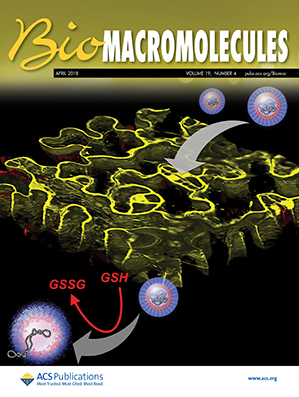Dual-Dynamic Covalently Cross-Linked Polyglycerol Hydrogels for Tumor Spheroid Culture
IF 5.4
2区 化学
Q1 BIOCHEMISTRY & MOLECULAR BIOLOGY
引用次数: 0
Abstract
Advancing cancer research depends significantly on developing accurate and reliable models that can replicate the complex tumor microenvironment. Tumor spheroidsthree-dimensional clusters of cancer cellshave become crucial tools for this purpose. The overarching goal of tumor spheroid culture is to develop biomaterials that mimic the dynamic mechanical behavior of the native extracellular matrix, enabling high-fidelity culture models. In this study, we developed dynamic hydrogels based on dual-dynamic covalently cross-linked polyglycerol, using boronate bonds and Schiff-base interactions. In addition to good biocompatibility and long-term stability, the hydrogels showed tunable mechanical properties that enabled cells to actively remodel their surrounding microenvironment. This platform was used for successful 3D culture of various cancer cell lines, including HeLa, A549, HT-29, BT-474, and SK-BR-3, which were encapsulated in situ and formed 3D tumor spheroids. These results demonstrate the feasibility and versatility of our dynamic hydrogel system in supporting tumor spheroid culture.
- Download: Download high-res image (120KB)
- Download: Download full-size image
肿瘤球体培养用双动态共价交联聚甘油水凝胶。
推进癌症研究在很大程度上取决于开发准确可靠的模型,这些模型可以复制复杂的肿瘤微环境。肿瘤球体──癌细胞的三维簇──已成为实现这一目标的重要工具。肿瘤球体培养的首要目标是开发模拟原生细胞外基质动态力学行为的生物材料,实现高保真培养模型。在这项研究中,我们开发了基于双动态共价交联聚甘油的动态水凝胶,利用硼酸键和希夫碱相互作用。除了良好的生物相容性和长期稳定性外,水凝胶还显示出可调节的机械性能,使细胞能够主动重塑周围的微环境。利用该平台成功对HeLa、A549、HT-29、BT-474、SK-BR-3等多种癌细胞进行了三维培养,原位包封形成三维肿瘤球体。这些结果证明了我们的动态水凝胶系统在支持肿瘤球体培养方面的可行性和通用性。
本文章由计算机程序翻译,如有差异,请以英文原文为准。
求助全文
约1分钟内获得全文
求助全文
来源期刊

Biomacromolecules
化学-高分子科学
CiteScore
10.60
自引率
4.80%
发文量
417
审稿时长
1.6 months
期刊介绍:
Biomacromolecules is a leading forum for the dissemination of cutting-edge research at the interface of polymer science and biology. Submissions to Biomacromolecules should contain strong elements of innovation in terms of macromolecular design, synthesis and characterization, or in the application of polymer materials to biology and medicine.
Topics covered by Biomacromolecules include, but are not exclusively limited to: sustainable polymers, polymers based on natural and renewable resources, degradable polymers, polymer conjugates, polymeric drugs, polymers in biocatalysis, biomacromolecular assembly, biomimetic polymers, polymer-biomineral hybrids, biomimetic-polymer processing, polymer recycling, bioactive polymer surfaces, original polymer design for biomedical applications such as immunotherapy, drug delivery, gene delivery, antimicrobial applications, diagnostic imaging and biosensing, polymers in tissue engineering and regenerative medicine, polymeric scaffolds and hydrogels for cell culture and delivery.
 求助内容:
求助内容: 应助结果提醒方式:
应助结果提醒方式:


